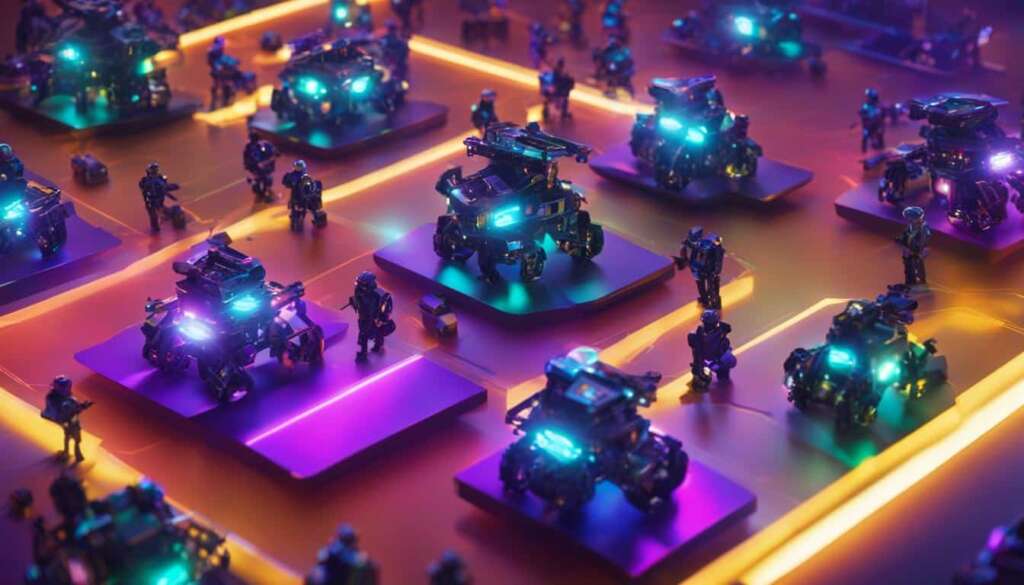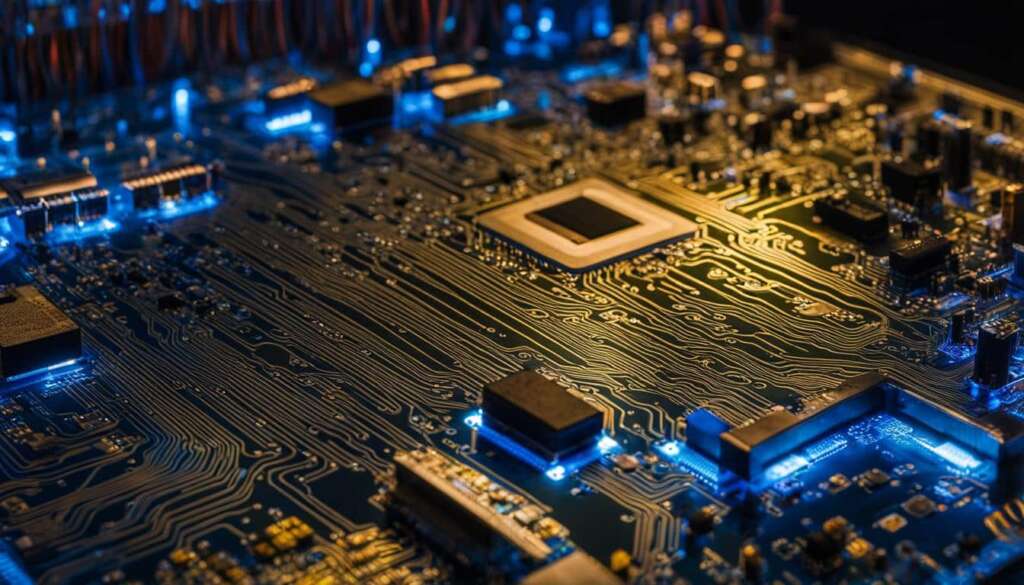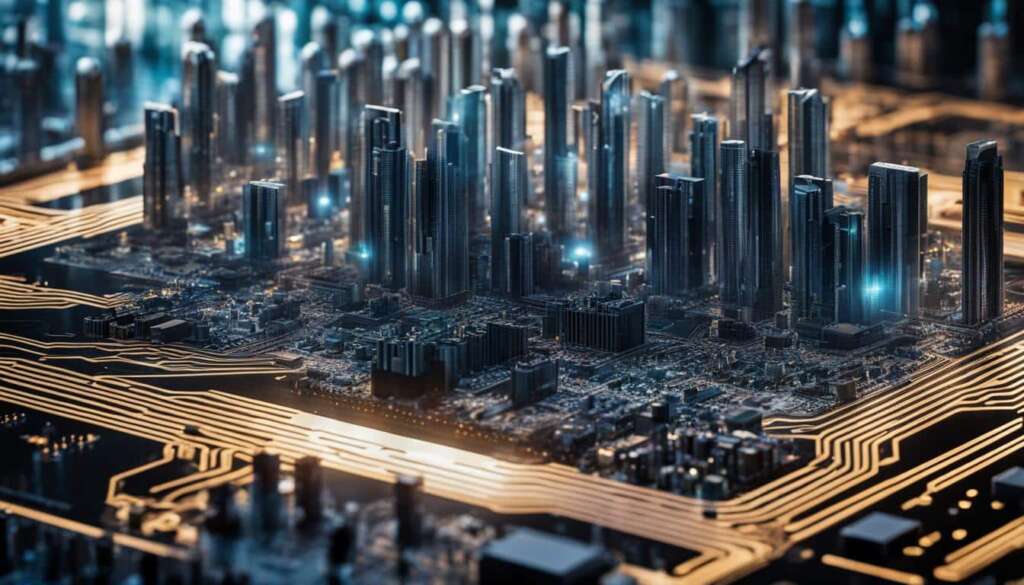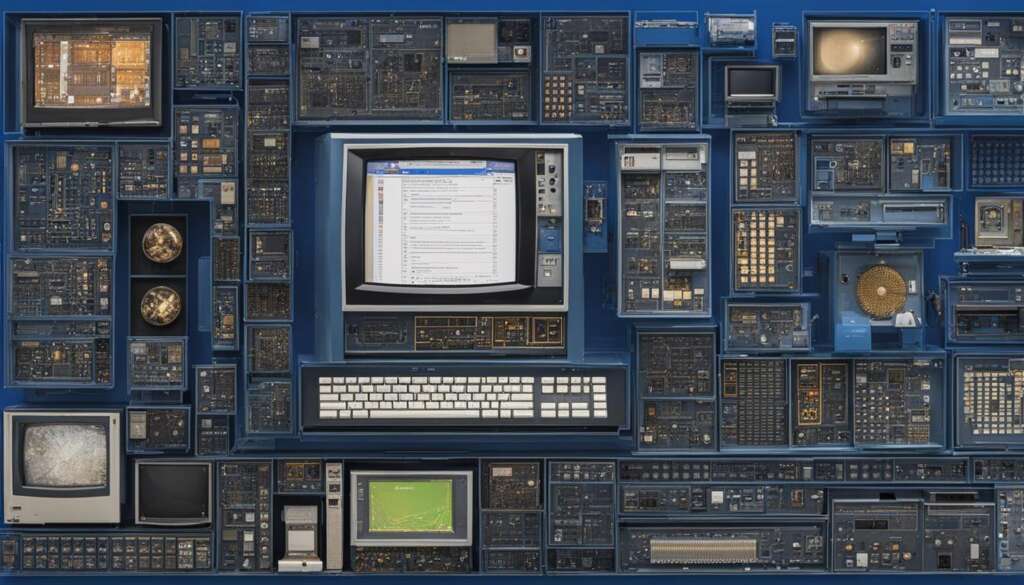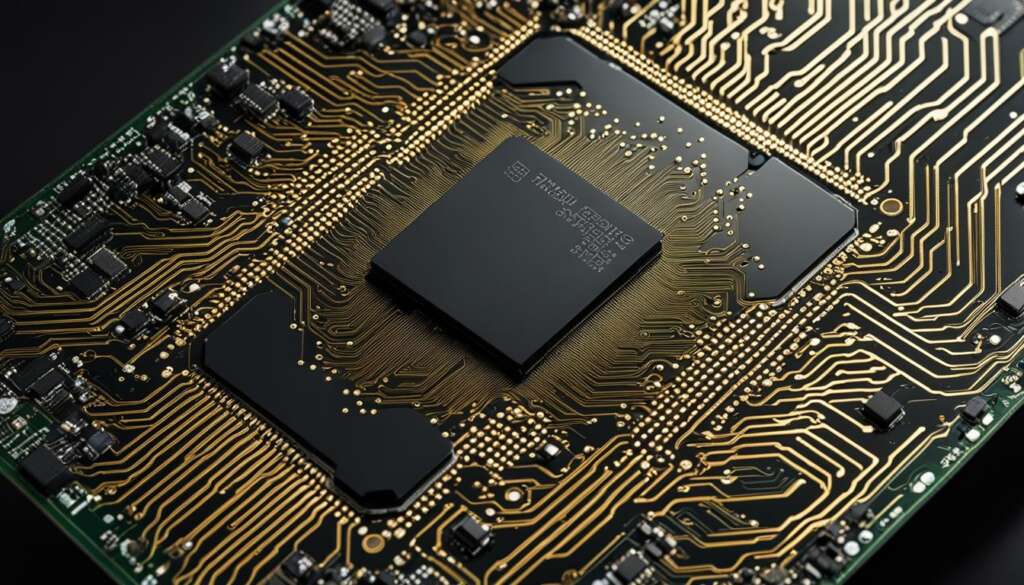Table of Contents
Swarm Robotics is a fascinating field that explores the collective intelligence and cooperation of robotic swarms. These swarms, consisting of multiple autonomous robots, work together to accomplish tasks without relying on a centralized control system. Inspired by natural behavior observed in birds, fish, and bees, swarm robotics utilizes swarm intelligence to achieve complex behaviors such as navigation and decision-making.
Swarm robotics has a wide range of applications in various industries, including disaster relief, research mapping, military, environmental monitoring, logistics, and agriculture. These multi-robot systems, also known as distributed or self-organizing robots, offer unique advantages in terms of efficiency, flexibility, and scalability.
By leveraging the power of cooperative robotics, swarm robots can perform tasks that would be challenging or impossible for a single robot to accomplish alone. The autonomy of swarm robots, combined with their ability to interact with each other and the environment, makes them intelligent agents capable of adapting to changing situations.
In the following sections, we will delve deeper into the fundamentals of swarm robotics, key behaviors exhibited by swarm robots, real-world applications, technical challenges, design and modeling techniques, and the future of this exciting field. Join us as we explore the incredible potential of swarm robotics in revolutionizing various industries.
The Fundamentals of Swarm Robotics
Swarm robotics is a fascinating field that involves a coordinated group of robots, often referred to as a “swarm,” working together to achieve a common goal. Unlike traditional robotics, swarm robotics relies on coordination and collaboration among individual robots, rather than a centralized control system. Each robot in the swarm operates autonomously, making decisions based on local behaviors and a simple set of rules.
In a robot swarm, there are typically three or more individual entities that work together towards a shared objective. These robots interact with each other and their environment, using sensors and algorithms to navigate, communicate, and cooperate. The coordination in a swarm is based on a simple set of rules that dictate the robot’s behavior, allowing the robots to work together seamlessly.
One key aspect of swarm robotics is the ability of the robots to exhibit local behaviors. These local behaviors are individual actions performed by each robot based on its perception of the environment and the interactions with other robots. Through the combination of these local behaviors, the swarm as a whole can achieve complex tasks and behaviors.
“Swarm robotics is an exciting field that combines the power of multiple autonomous agents to accomplish tasks that would be difficult or impossible for a single robot.”
Swarm robotics is often compared to a sensor network or a multi-agent system, but there are some key differences. In a sensor network, the focus is primarily on collecting data from the environment, while swarm robotics involves active interaction and coordination among the robots. Additionally, in a multi-agent system, the agents usually have a higher level of autonomy and individual decision-making capabilities, whereas swarm robots typically operate based on simple rules and rely on coordination to achieve their goals.
Overall, swarm robotics offers a unique approach to robotics, with applications in various industries and fields. By harnessing the power of a swarm of robots and their ability to coordinate and collaborate, swarm robotics opens up new possibilities for solving complex problems and achieving tasks that were previously challenging for single robots.
The Fundamentals of Swarm Robotics
| Concept | Description |
|---|---|
| Swarm of Robots | A coordinated group of individual robots working together towards a common goal. |
| Coordination | The ability of robots in a swarm to interact and cooperate with each other based on a simple set of rules. |
| Local Behaviors | Individual actions performed by each robot based on its perception of the environment and interactions with other robots. |
| Simple Set of Rules | The guidelines that govern the behavior of each robot in the swarm, enabling coordination and collaboration. |
| Autonomous Agents | Individual robots in the swarm that operate autonomously, making decisions based on local behaviors and rules. |
| Sensor Network | A network of sensors that collect data from the environment, often without active coordination or collaboration. |
Key Behaviors in Swarm Robotics
Swarm robotics encompasses various behaviors that allow robots in a swarm to interact with their environment and accomplish tasks. These behaviors can be categorized into spatial organization, navigation, decision-making, and miscellaneous behaviors.
Spatial Organization Behaviors
Spatial organization behaviors in swarm robotics involve the coordination of robots to achieve specific formations and patterns. These behaviors include object clustering and assembly, pattern formation, chain formation, self-assembly, morphogenesis, and aggregation. By utilizing these behaviors, swarm robots can work together in an organized manner to complete complex tasks.
Navigation behaviors enable a swarm of robots to move harmoniously within their environment. This includes collective localization, where robots determine their positions relative to each other and the surrounding objects. Additionally, swarm robots can perform collective transport, coordinated motion, and collective exploration, allowing them to navigate efficiently and effectively.
Decision-Making Behaviors
Decision-making behaviors in swarm robotics involve the collective intelligence and cooperation of the robots to make informed decisions. These behaviors include group size regulation, where robots adjust their numbers to optimize task performance, and collective fault detection, where robots work together to identify and rectify errors. Other decision-making behaviors include synchronization, collective perception, task allocation, and consensus, enabling swarm robots to make decisions collectively.
Miscellaneous Behaviors
In addition to spatial organization, navigation, and decision-making behaviors, swarm robotics encompasses miscellaneous behaviors that enhance the capabilities of the swarm. These behaviors include self-healing, where robots autonomously repair themselves or each other, and self-reproduction, where swarm robots can create new robots to expand their numbers or replace damaged units.
Understanding and harnessing these key behaviors in swarm robotics is crucial for developing advanced and efficient multi-robot systems. By leveraging spatial organization, navigation, decision-making, and miscellaneous behaviors, swarm robots can achieve complex tasks and operate in unison, making swarm robotics a promising field with numerous business applications.
Applications of Swarm Robotics
Swarm robotics is a versatile technology with applications across various industries. Let’s explore some of the key areas where swarm robotics can make a significant impact.
Environmental Monitoring
In the field of environmental monitoring, swarm robotics can play a crucial role in detecting and responding to pollution and other environmental hazards. Swarms of robots equipped with sensors can collect real-time data about air quality, water pollution, or chemical leaks. These robots can navigate through challenging terrains and access hard-to-reach areas, providing valuable insights for environmental conservation efforts.
Disaster Recovery
In the aftermath of natural disasters or large-scale emergencies, swarm robotics can aid in disaster recovery operations. Swarms of robots can be deployed to search for survivors in hazardous environments, gather information about the disaster-affected areas, and assist in the coordination of rescue efforts. These robots can navigate through debris and provide valuable data for future disaster mitigation strategies.
Infrastructure Maintenance and Logistics
Swarm robotics can streamline infrastructure maintenance tasks, such as inspections and repairs. Miniature autonomous robots can be deployed to inspect bridges, pipelines, or power lines, identifying potential maintenance issues or structural damages. In logistics, swarm robotics can optimize transportation and warehouse management, improving efficiency and coordination in tasks such as inventory management and route planning.
Military Industry
The military industry can leverage swarm robotics for various applications, including battlefield awareness and target search. Swarms of robots equipped with sensors and communication capabilities can gather real-time intelligence, enhance situational awareness, and assist in reconnaissance missions. These robots can perform surveillance tasks, search for targets, and support military operations in challenging environments.
Agriculture
In the agricultural sector, swarm robotics can revolutionize farming practices. Swarms of robots can assist in crop monitoring, pest control, and pollination, optimizing agricultural processes and ensuring sustainable practices. These robots can collect data on soil quality, plant health, and pest infestations, enabling farmers to make informed decisions and maximize crop yields.
| Applications | Description |
|---|---|
| Environmental Monitoring | Utilizing robots equipped with sensors to detect pollution and monitor environmental conditions. |
| Disaster Recovery | Deploying swarm robots for search and rescue operations in disaster-stricken areas. |
| Infrastructure Maintenance and Logistics | Using swarm robotics for inspecting and maintaining critical infrastructure and optimizing logistics processes. |
| Military Industry | Leveraging swarm robots for military applications, including reconnaissance and situational awareness. |
| Agriculture | Applying swarm robotics for crop monitoring, pest control, and pollination in the agricultural sector. |
Swarm Robotics and Business Models
Swarm robotics is poised to disrupt the business landscape, with the potential to generate additional revenue streams and leverage emerging technologies. One of the key opportunities lies in the Machine-to-Machine (M2M) economy, where companies can sell the data collected by their swarm robots as a service to other participants in the economy. This concept, known as Sensing as a Service, allows companies to monetize the valuable data collected by their swarm robotics solutions. By participating in the M2M economy, businesses can tap into a growing market and create new sources of income.
Furthermore, swarm robotics can benefit from the integration of blockchain technology. Blockchain offers a decentralized approach to agreements and transactions, eliminating the need for a controlling authority. Companies can leverage blockchain to securely facilitate interactions between swarm robots and external stakeholders, ensuring transparency and trust in the ecosystem. This opens up possibilities for innovative business models and collaborations within the swarm robotics industry.
In addition to the M2M economy and blockchain, companies may also explore the potential of creating marketplaces for swarm robotics services. These marketplaces can act as platforms where businesses can rent swarm robots for specific tasks and services. For example, a construction company could analyze and monitor a construction site using swarm robotics technology rented through such a marketplace. By providing access to swarm robotics services on-demand, marketplaces can foster collaboration and drive innovation in various industries.
Table: Potential Business Models for Swarm Robotics
| Business Model | Description |
|---|---|
| Sensing as a Service | Companies sell data collected by swarm robots as a service to other participants in the M2M economy. |
| Blockchain-enabled Transactions | Utilizing blockchain technology for secure and transparent interactions within the swarm robotics ecosystem. |
| Marketplaces | Creating platforms where businesses can rent swarm robots for specific tasks and services. |
In conclusion, swarm robotics presents exciting opportunities for businesses to generate additional revenue streams, drive innovation, and create new business models. By embracing the M2M economy, leveraging blockchain technology, and exploring the potential of marketplaces, companies can unlock the full potential of swarm robotics and stay ahead in the rapidly evolving technological landscape.
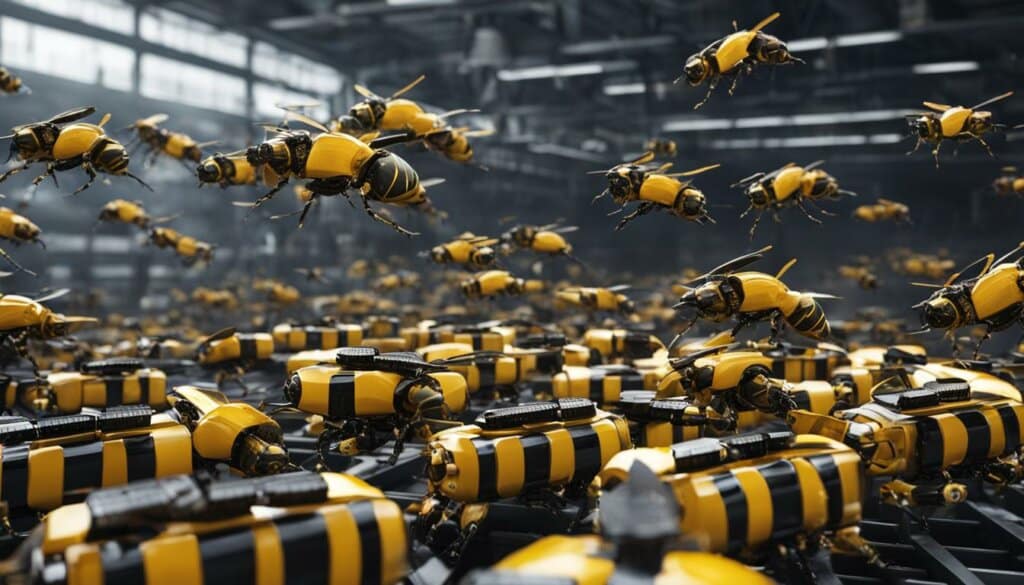
Technical Challenges in Swarm Robotics
Swarm robotics presents several technical challenges that need to be addressed for the successful implementation of swarm systems in real-world scenarios. One of the primary challenges is dealing with the computational complexity of swarm systems. As the number of robots in a swarm increases, the computational requirements for coordinating their behavior and decision-making also increase significantly. Efficient algorithms and distributed processing techniques need to be developed to handle this complexity and ensure the scalability of swarm robotics solutions.
Adaptation is another critical challenge in swarm robotics. As swarm robots operate in dynamic and unpredictable environments, they need to be able to adapt their behavior and decision-making processes based on changing circumstances. This requires the development of sophisticated adaptive algorithms and learning mechanisms that enable swarm robots to respond effectively to environmental changes and achieve their objectives.
Communication is also a significant challenge in swarm robotics. As individual robots in a swarm need to coordinate their actions and share information, efficient communication protocols need to be designed to facilitate this exchange of data. The communication system should be robust, reliable, and able to handle the large-scale communication requirements of swarm systems.
Sensing and algorithm design
Effective sensing is crucial for swarm robots to perceive their environment accurately and make informed decisions. Designing and integrating suitable sensors into swarm robots is a technical challenge that needs to be addressed. The sensors should be capable of providing relevant and reliable data to swarm robots, enabling them to navigate, interact with objects, and perform tasks effectively.
Algorithm design is another challenge in swarm robotics. Different swarm behaviors and tasks require specific algorithms that govern the interactions and decision-making processes of the robots. Designing efficient and robust algorithms that can handle various behaviors, such as navigation, pattern formation, and task allocation, is a complex task that requires in-depth research and development.
Ensuring security within a swarm is also a crucial challenge. As swarm robots operate autonomously and interact with their environment, they need to be protected against cyber-attacks and unauthorized access. Developing secure communication protocols and implementing robust security measures is essential to safeguard swarm systems from potential threats.
| Technical Challenges in Swarm Robotics |
|---|
| Computational Complexity |
| Adaptation |
| Communication |
| Sensing |
| Algorithm Design |
| Security |
| Different Behaviors |
Design and Modeling of Swarm Robotic Systems
Designing and modeling swarm robotic systems involves creating mathematical models that capture the collective behaviors emerging from local interactions among robots. These models serve as a basis for understanding and predicting the behavior of swarm systems at both the individual and swarm levels. By studying the interactions and dynamics within a swarm, researchers can develop formal design methods that enable the analysis and optimization of swarm behavior.
The mathematical models used in swarm robotics can vary depending on the specific behaviors being studied. For example, models may focus on how individual robots make decisions based on local information, how the swarm adapts to changes in the environment, or how robots coordinate their movements to accomplish collective tasks. These models often involve concepts from fields such as graph theory, optimization, and control theory.
Formal design methods complement these mathematical models by providing a framework for designing and controlling swarm robotic systems. These methods help engineers and researchers to define the desired collective behaviors, develop algorithms that implement these behaviors, and evaluate the performance of the swarm in different scenarios. Formal design methods also facilitate the systematic exploration of design space, allowing for the identification of optimal configurations and parameters for swarm systems.
| Mathematical Models in Swarm Robotics | Formal Design Methods in Swarm Robotics |
|---|---|
|
|
Mathematical models and formal design methods are essential tools in swarm robotics as they provide insights into the emergent behaviors and enable the systematic design and analysis of swarm systems. These approaches contribute to the development of scalable, robust, and efficient swarm robotic solutions that can be applied across various domains.
Real-World Scenarios and Use Cases of Swarm Robotics
Swarm robotics has shown promise in various real-world scenarios and use cases, demonstrating its potential for transforming industries. One notable application is in environmental monitoring, where swarms of robots can be deployed to detect chemical leaks, monitor pollution levels, and locate the source of contamination. These autonomous robots can navigate challenging terrain, gather data in real-time, and provide valuable insights for environmental management and protection.
The military industry is another domain where swarm robotics has proven valuable. Swarms of robots can be deployed for mapping and surveillance missions, enhancing battlefield awareness, and aiding in target search operations. The ability of these robotic swarms to collaboratively gather intelligence and perform coordinated actions can greatly improve military operations and strategic decision-making.
Disaster recovery efforts can also benefit from the use of swarm robots. In scenarios such as earthquakes, floods, or other natural disasters, these robots can be deployed to search for survivors in hard-to-reach areas, assess the structural integrity of buildings, and provide critical information for rescue teams. The autonomous nature of swarm robotics allows for efficient and simultaneous exploration of multiple areas, increasing the chances of locating survivors and improving overall disaster response.
| Use Cases | Description |
|---|---|
| Environmental Monitoring | Deploying swarms of robots to detect chemical leaks, pollution levels, and locate contamination sources. |
| Military Industry | Utilizing robotic swarms for mapping, target search, surveillance, and enhancing battlefield awareness. |
| Disaster Recovery | Deploying swarm robots for search and rescue operations, assessing structural integrity, and aiding rescue teams. |
While these use cases demonstrate the potential of swarm robotics, scalability remains a challenge. The cost of robot platforms and the complexity of hardware currently limit the widespread adoption of swarm robotics solutions. However, ongoing advancements in technology, coupled with further research and development, hold the promise of overcoming these limitations and unlocking the full potential of swarm robotics in the future.
The Future of Swarm Robotics
As swarm robotics continues to evolve, researchers are focused on addressing hardware limitations, improving the autonomous aspect of swarm systems, and conducting further research to develop better algorithms and communication systems. These advancements are crucial for achieving scalable, robust, and flexible swarm robotics solutions that can adapt to changing tasks and circumstances in real-world applications.
Hardware Limitations
Hardware plays a significant role in the future of swarm robotics. As technology progresses, there is a need for more advanced and cost-effective robot platforms that can withstand various environmental conditions and perform complex tasks. Overcoming hardware limitations will involve innovations in miniaturization, power efficiency, durability, and sensor integration. By enhancing the hardware capabilities of swarm robots, researchers can unlock new possibilities for swarm robotics applications.
Autonomous Aspect
The autonomous aspect of swarm systems is a crucial area of focus for future research. Enhancing the autonomy of individual robots within a swarm will enable them to make intelligent decisions and adapt to dynamic environments. This requires developing sophisticated algorithms that allow robots to perceive their surroundings, communicate with each other, and collectively solve complex problems. By achieving a higher level of autonomy, swarm robotics can become more efficient, adaptable, and resilient in various scenarios.
Further Research
Further research is essential to bridge the gap between theoretical advancements in swarm robotics and their practical implementation in industrial settings. This involves investigating the dynamics of collective decision-making, behavior adaptation, and the integration of different sensors within a swarm. Additionally, exploring new algorithmic approaches, communication protocols, and coordination mechanisms will contribute to the development of more intelligent and cooperative swarm robotics systems. With ongoing research and collaboration, the future of swarm robotics holds promising prospects for revolutionizing various industries.
| Challenges | Focus Areas |
|---|---|
| Hardware Limitations | Innovations in miniaturization, power efficiency, durability, and sensor integration |
| Autonomous Aspect | Development of sophisticated algorithms for intelligent decision-making and adaptation |
| Further Research | Dynamics of collective decision-making, behavior adaptation, and integration of different sensors |

“Advancements in hardware, autonomy, and research will shape the future of swarm robotics, revolutionizing industries and unlocking new possibilities for intelligent and cooperative systems.”
Conclusion
In conclusion, swarm robotics is a transformative field with significant business applications. The collective intelligence and cooperation observed in swarm behavior have the potential to revolutionize various industries. From disaster relief and environmental monitoring to logistics and the military industry, swarm robotics offers innovative solutions for complex tasks.
However, there are still technical challenges that need to be addressed to fully unlock the potential of swarm robotics. Computational complexity, adaptation within the swarm, efficient communication protocols, and the integration of sensors are just a few of the hurdles that researchers and developers must overcome. Additionally, the scalability of swarm robotics remains a challenge, requiring advancements in hardware and algorithms.
Despite these challenges, the future of swarm robotics is promising. Ongoing research and advancements in hardware, algorithms, and communication systems will drive the development of scalable, robust, and flexible swarm solutions. The autonomous aspect of swarm systems will continue to improve, allowing for better decision-making and adaptability in dynamic environments.
In conclusion, swarm robotics represents a disruptive technology that has the potential to transform business processes. With continued innovation and collaboration between academia and industry, swarm robotics will play a pivotal role in shaping the future of automation and intelligent systems.
FAQ
What is swarm robotics?
Swarm robotics involves a group of independent robots working collaboratively to complete a shared task without relying on any external infrastructure or a centralized control system/robot.
What is swarm intelligence?
Swarm intelligence is a concept in swarm robotics that draws inspiration from natural behavior observed in birds, fish, and bees, where the robots interact autonomously with each other and their environment.
What are the applications of swarm robotics?
Swarm robotics has applications in various industries, including disaster relief, research mapping, military industry, environmental monitoring, infrastructure maintenance, logistics, and agriculture.
How can swarm robotics benefit from the Machine-to-Machine (M2M) economy?
Swarm robotics can benefit from the M2M economy by selling collected data from swarm robots to other participants in the economy, known as Sensing as a Service. It can also leverage blockchain technology for decentralized agreements and transactions without the need for a controlling authority.
What are the technical challenges in swarm robotics?
Technical challenges in swarm robotics include dealing with computational complexity, enabling adaptation within the swarm, developing efficient communication protocols, integrating and utilizing sensors effectively, designing suitable algorithms, ensuring security within the swarm, and handling the combination of different behaviors.
How are swarm robotic systems designed and modeled?
Swarm robotic systems are designed and modeled using mathematical models that capture the collective behaviors emerging from local interactions among robots. This allows for the analysis and prediction of swarm system behavior at both individual and swarm levels.
What are some real-world scenarios and use cases of swarm robotics?
Real-world scenarios and use cases of swarm robotics include environmental monitoring, military applications such as mapping and target search, disaster recovery efforts, and infrastructure maintenance.
What is the future of swarm robotics?
The future of swarm robotics lies in achieving scalable, robust, and flexible solutions that can adapt to changing tasks and circumstances. Further research is needed to bridge the gap between theoretical and industrial applications, paving the way for widespread adoption.
Source Links
- https://www.mdpi.com/2504-446X/7/4/269
- https://towardsdatascience.com/swarm-robotics-projects-new-business-models-technical-challenges-d6fa845e56af
- https://link.springer.com/book/10.1007/978-3-319-74528-2

